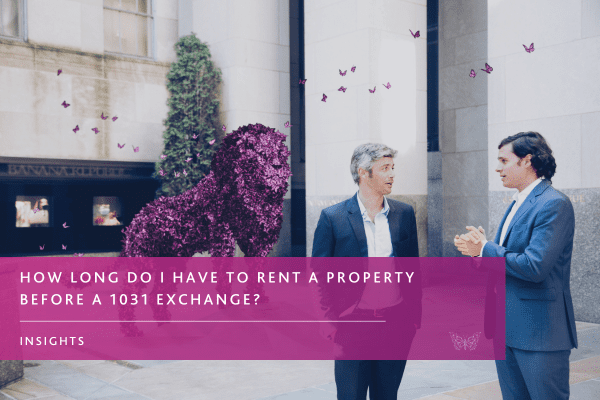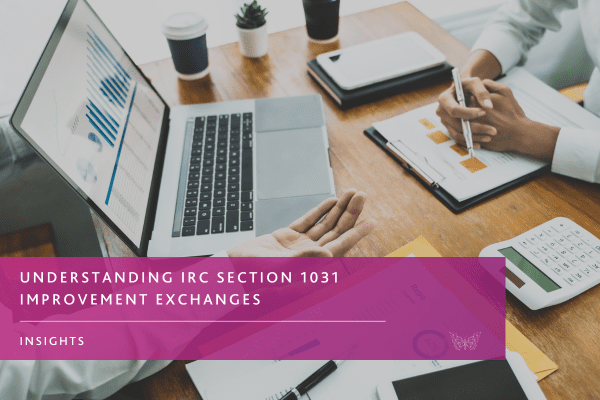There’s no hard and fast rule about what separates an investment property from a property held for sale. To qualify under Section 1031, you need to understand the concept of intent.
One of the advantages of Section 1031 like-kind exchanges is that there is no limit to the number of exchanges one can perform. If you exchange a single-family home for a duplex this year, you can eventually exchange that duplex for an apartment building, and the apartment building for another like-kind property, and so on. It’s possible to continue exchanging up until your death, maximizing the benefits of 1031 tax deferral.
Property owners often want to know how frequently they’re allowed to exchange – that is, how long does one have to hold a 1031 property before executing another exchange? Unfortunately, like so much with our tax laws, the answer isn’t straightforward.
What the law says about 1031 holding times
It would be nice if the IRS mandated a specific amount of time a property must be held in order to qualify under Section 1031, but alas, it hasn’t. There is no hard and fast rule about how long you must hold a property before a like-kind exchange.
The law does say that in order to qualify for Section 1031 tax deferral, the relinquished and replacement properties must both be “real property held for productive use in a trade or business or for investment” and that tax deferral benefits “shall not apply to any exchange of real property held primarily for sale.”
These two rules – that the property must be held for productive business or investment purposes and that it can’t be held primarily for sale – can seem vague. What qualifies as “productive use?” What’s the difference between holding a property “for investment” and “primarily for sale?”
What is at issue is the concept of intent. The IRS wants to be sure your intention was to use the property as part of a business or that you intended to hold it as a long-term investment. What they don’t want is to allow tax deferral for someone whose vocation is flipping and selling houses – such a person would be considered a “dealer” of real estate, with property being their stock-in-trade.
JTC’s Justin Amos explained this idea on a recent podcast appearance:
“The IRS hasn’t given us a direct line in the sand for how long someone should hold. They look at what’s called the intent. If my intent was to hold it as a long-term hold, for business, they’ll excuse it. Now, your CPA and attorney will have to defend that intent, because fix and flips don’t work as an exchange property.”
Because there is no hard and fast rule, the IRS will look at how you used the property as well as how long you held it. In general, the longer you hold a property, the easier it will be to make the case that it was an investment, but that’s not the only criteria. That’s why it’s not possible to say definitively whether or not any specific property will qualify.
In many cases, purchasing undeveloped land with the intent to develop and then sell that land will not qualify because the intent is to sell the property as quickly as possible. But if you develop that land and then rent it out to tenants for a period of time, it could potentially qualify. How long should you rent the property? Since the law contains no definite rule, we have to rely on case history and IRS revenue procedures.
Rev. Proc. 2008-16 outlines a “safe harbor” under which the IRS “will not challenge whether a dwelling unit qualifies as property held for productive use in a trade or business or for investment.” The property discussed is a vacation home that isn’t the taxpayer’s primary residence and is occasionally rented out. Prior case history indicates that the “mere hope or expectation that property may be sold at a gain cannot establish an investment intent if the taxpayer uses the property as a residence.”
Under Revenue Procedure 2005-14, a personal residence cannot qualify, even if it is not the taxpayer’s main home. But if the property is rented out part of the year, it may qualify because of this business use. Rev. Proc. 2008-16 says an exchange is allowed under these qualifying use standards:
- The taxpayer must own the dwelling for at least 24 months prior to the exchange;
- In the two years prior to the exchange, the dwelling is rented to another person at a fair market price for at least 14 days of each year; and
- The taxpayer’s personal use does not exceed the greater of 14 days or 10% of the days that it is rented during each 12-month period.
A vacation home can be used as part of a 1031 exchange under these circumstances. But this is not the only scenario under which people execute like-kind exchanges. Your individual situation matters, and if you don’t meet the exact scenario described above, you could still qualify.
How long exchangers are usually advised to hold a property prior to a 1031 exchange
If we go by what is set forth in Rev. Proc. 2008-16, you would want to hold your property for at least 24 months prior to your exchange. Indeed, many professionals may advice you to hold for two years at minimum just to be safe. But if you’ve done enough to establish business or investment use in one year, you might be able to proceed. That’s why it’s important to consult with your CPA and legal advisers, who will be tasked with defending your exchange if the IRS disagrees with its validity.
A major factor is consistent use: if you spend 11 months performing a remodel on a single-family home, then rent it out for a month before selling it, that may not be deemed business use because the remodel was clearly done to prepare the property for sale. You’ll want any business use to be consistent and well-documented. Any lease agreements, repairs, and information on the business housed on the property will bolster your case that the property was used for business or investment and not simply held for sale.
How long should I rent my primary residence before doing a 1031 exchange?
As we’ve noted before, it is possible to combine the IRC Section 121 exclusion and a Section 1031 like-kind exchange. You can move out of your primary residence, rent it for a period of time to establish business use, and then sell it in a 1031 exchange.
“If you were to rent it out for a few years, hold it for business for a period of two years prior to selling, then you would have the ability to do Section 1031,” said Amos at a JTC webinar. “You’ll hold that property as an investment property, which will allow you to qualify for a Section 1031 exchange. The 121 exemption, as long as you’ve lived in the home within a five-year period prior to converting it into an investment property, you can exclude up to $500,000 if a married couple or $250,000 in capital gains taxes as an individual.”
This means a taxpayer could potentially use the Section 121 exemption to receive some of the proceeds from the property sale, while using the rest to invest in a new property with a 1031 exchange, deferring the taxes on the 1031 portion. This is possible because the parameters for Section 121 and Section 1031 are not mutually exclusive, allowing taxpayers to utilize both as part of a tax and investing strategy.
Specific rules for related-party exchanges
It’s important to note that just because your exchange is allowed at the time, that doesn’t mean you’re free and clear. There are specific rules that govern related-party exchanges, which we’ve covered in a previous post, and some apply here.
A related-party exchange won’t qualify if the buyer of the relinquished property disposes of it within two years, or the taxpayer disposes of the replacement property within two years. In those cases, there is a hard and fast rule, and your exchange could be ruled invalid long after it is performed, which is why related-party exchanges can be risky.
When exceptions are made – the “Godfather offer”
If there’s one thing to understand about tax law, it’s that there is plenty of room for interpretation when it comes to the Internal Revenue Code, and the IRS makes a lot of exceptions. It’s true that in most circumstances, holding a property for two years or more is a good way to establish intent. But what if it’s only been a few months, and you get an offer you just can’t turn down? Amos refers to this as the “Godfather offer,” and explained it like this:
“You purchased a property with the intent of holding it maybe one to two years, or even longer than that. Someone knocks on your door, and says, ‘I want to buy it for double what you bought it, because I just really like the land,’ or location, or what have you. The IRS is not going to tell you, if you only held it for five months, that you can’t do an exchange. As long as you build the case, you show that you rented it out, and you have a good audit trail, it’ll work.”
No matter how the IRS treats an exchange in most situations, they may be willing to make an exception in your situation. Maybe. You need to be able to defend your choice, prove intent, and document everything. When asked how one might go about proving a “Godfather offer” situation, Amos said, “That’s something for you and your CPA to discuss.”
Putting yourself in position for a successful exchange
Holding property and establishing intent are necessary for a valid 1031 exchange, but there are many other rules that must be followed. The exchanger cannot take receipt of funds from the relinquished property sale during the exchange, and properties must be identified in a specific manner. Even if you’re able to justify why you want to perform an exchange, if you don’t do it the right way, it may be ruled invalid.
Every exchange needs a Qualified Intermediary (QI) to hold funds during the exchange. At JTC, we follow best practices for 1031 exchanges that include holding exchange funds in qualified escrow or trust accounts and only releasing funds with dual authorization from the exchanger and JTC. We also have experience with complex exchange scenarios like reverse exchanges and those involving Delaware Statutory Trusts. Before you start your exchange, talk to a JTC representative about how we can help.
To learn more about JTC’s 1031 exchange services, click here.
Stay Connected
Stay up to date with expert insights, latest updates and exclusive content.
Let’s Bring Your Vision to Life
From 2,300 employee owners to 14,000+ clients, our journey is marked by stability and success.




















